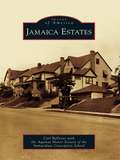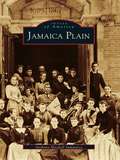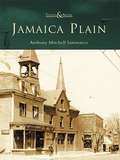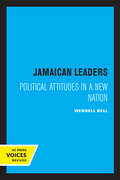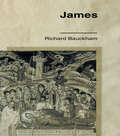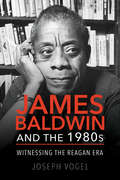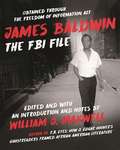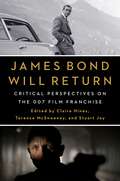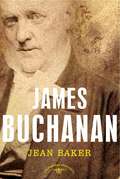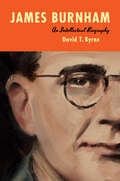- Table View
- List View
Jamaica Estates
by Carl Ballenas Aquinas Honor Society of the Immaculate Conception SchoolThe Jamaica Estates community evolved with the advent of the 20th century. The verdant hills north of the colonial village of Jamaica were blanketed with forests of deciduous trees and dotted with crystal clear glacial lakes. The area's country beauty and tranquility offered people an escape from the congestion of the crowded city. As the Queensborough Bridge neared completion in 1907, two wealthy real estate speculators, Ernestus Gulick and Felix Isman, envisioned a unique community. Together they imagined a residential park offering people the ability to have homes in an area of breathtaking country beauty while working in the city.
Jamaica Inn (Vmc Ser. #515)
by Daphne du MaurierA classic tale of murder, mystery and romance by one of the twentieth-century's best storytellers. Now a prime-time BBC drama.
Jamaica Inn: The thrilling gothic classic from the beloved author of REBECCA (Virago Modern Classics #12)
by Daphne Du MaurierAN UNFORGETTABLE STORY OF MURDER, MYSTERY AND PASSION, FROM THE BESTSELLING AUTHOR OF REBECCA.'Jamaica Inn is a first-rate page-turner' THE TIMES'Daphne du Maurier has no equal' SUNDAY TELEGRAPH 'Jamaica Inn is a novel about nothing less than pure evil ... with an eerie and shocking kind of power, in the novel's astonishing final act' JULIE MYERSON, GUARDIAN In the bitter November wind, Mary Yellan crosses Bodmin Moor to Jamaica Inn. Her mother's dying wish was that she take refuge there with her Aunt Patience. But when Mary arrives, the warning of the coachman echoes in her mind. Jamaica Inn has a desolate power and behind its crumbling walls, Patience is a changed woman, cowering before her brooding, violent husband. When Mary discovers the inn's dark secrets, the truth is more terrifying than anything she could possibly imagine and she is forced to collude in her uncle's murderous schemes. Against her will, she finds herself powerfully attracted to her uncle's brother, a man she dares not trust.Jamaica Inn is a dark and gripping gothic tale that will remind readers of two other great classics, Jane Eyre and Wuthering Heights. This was also made into a film, also called Jamaica Inn, directed by Alfred Hitchcock.
Jamaica Inn: The thrilling gothic classic from the beloved author of REBECCA (Virago Modern Classics #12)
by Daphne Du MaurierAN UNFORGETTABLE STORY OF MURDER, MYSTERY AND PASSION, FROM THE BESTSELLING AUTHOR OF REBECCA.'Jamaica Inn is a first-rate page-turner' THE TIMES'Daphne du Maurier has no equal' SUNDAY TELEGRAPH 'Jamaica Inn is a novel about nothing less than pure evil ... with an eerie and shocking kind of power, in the novel's astonishing final act' JULIE MYERSON, GUARDIAN In the bitter November wind, Mary Yellan crosses Bodmin Moor to Jamaica Inn. Her mother's dying wish was that she take refuge there with her Aunt Patience. But when Mary arrives, the warning of the coachman echoes in her mind. Jamaica Inn has a desolate power and behind its crumbling walls, Patience is a changed woman, cowering before her brooding, violent husband. When Mary discovers the inn's dark secrets, the truth is more terrifying than anything she could possibly imagine and she is forced to collude in her uncle's murderous schemes. Against her will, she finds herself powerfully attracted to her uncle's brother, a man she dares not trust.Jamaica Inn is a dark and gripping gothic tale that will remind readers of two other great classics, Jane Eyre and Wuthering Heights. This was also made into a film, also called Jamaica Inn, directed by Alfred Hitchcock.
Jamaica Ladies: Female Slaveholders and the Creation of Britain's Atlantic Empire (Published by the Omohundro Institute of Early American History and Culture and the University of North Carolina Press)
by Christine Walker2020 Best Book Award, Society for the Study of Early Modern Women and GenderJamaica Ladies is the first systematic study of the free and freed women of European, Euro-African, and African descent who perpetuated chattel slavery and reaped its profits in the British Empire. Their actions helped transform Jamaica into the wealthiest slaveholding colony in the Anglo-Atlantic world. Starting in the 1670s, a surprisingly large and diverse group of women helped secure English control of Jamaica and, crucially, aided its developing and expanding slave labor regime by acquiring enslaved men, women, and children to protect their own tenuous claims to status and independence.Female colonists employed slaveholding as a means of advancing themselves socially and financially on the island. By owning others, they wielded forms of legal, social, economic, and cultural authority not available to them in Britain. In addition, slaveholding allowed free women of African descent, who were not far removed from slavery themselves, to cultivate, perform, and cement their free status. Alongside their male counterparts, women bought, sold, stole, and punished the people they claimed as property and vociferously defended their rights to do so. As slavery's beneficiaries, these women worked to stabilize and propel this brutal labor regime from its inception.
Jamaica Plain: Then And Now (Images of America)
by Anthony Mitchell SammarcoJamaica Plain: Then & Now is a fascinating photographic history of a Boston neighborhood once referred to as the "Eden of America." At one time a part of Roxbury and later West Roxbury, Jamaica Plain was annexed to the city of Boston in 1874. During the next five decades, the neighborhood expanded due to the railroad and streetcars and became known as one of the "streetcar suburbs." In this lavishly illustrated book, vintage images placed alongside contemporary photographs show well-known buildings and streetscapes as they once were and as they appear today. Included are Jamaica Pond, with its icehouses, and the area of Forest Hills, with the elevated line and streetcars, as well as schools, places of worship, and homes.
Jamaica Plain: Then And Now (Then and Now)
by Anthony Mitchell SammarcoJamaica Plain: Then & Now is a fascinating photographic history of a Boston neighborhood once referred to as the "Eden of America." At one time a part of Roxbury and later West Roxbury, Jamaica Plain was annexed to the city of Boston in 1874. During the next five decades, the neighborhood expanded due to the railroad and streetcars and became known as one of the "streetcar suburbs." In this lavishly illustrated book, vintage images placed alongside contemporary photographs show well-known buildings and streetscapes as they once were and as they appear today. Included are Jamaica Pond, with its icehouses, and the area of Forest Hills, with the elevated line and streetcars, as well as schools, places of worship, and homes.
Jamaica Street: A romantic saga that will have you gripped
by Sally Worboyes'She brings the East End to life' Barbara WindsorWhen Errol Turner, a handsome and determined young man from Jamaica, came to London's East End in the summer of 1955, his only assets were his father's old sewing machine, a few pounds in his pocket and a faith in the greatness of Britain. Four years later, in love with the charismatic Rita, he is making his mark as a tailor - but in the aftermath of the race riots, racial hatred still simmers throughout London, endangering all their hopes.Rita's best friend Maggie and her flamboyant great aunt Naomi try to ease the couple's fears. But far more sinister activities are going on under their own roof. When a woman is found murdered, vicious rumours and suspicions explode. It will take grit and cunning to bring the killer to light - and a true testing of friendship.A romantic saga that will have you gripped, perfect for fans of Kitty Neale, Nadine Dorries and Katie Flynn.
Jamaica Street: A romantic saga that will have you gripped
by Sally Worboyes'She brings the East End to life' Barbara WindsorWhen Errol Turner, a handsome and determined young man from Jamaica, came to London's East End in the summer of 1955, his only assets were his father's old sewing machine, a few pounds in his pocket and a faith in the greatness of Britain. Four years later, in love with the charismatic Rita, he is making his mark as a tailor - but in the aftermath of the race riots, racial hatred still simmers throughout London, endangering all their hopes.Rita's best friend Maggie and her flamboyant great aunt Naomi try to ease the couple's fears. But far more sinister activities are going on under their own roof. When a woman is found murdered, vicious rumours and suspicions explode. It will take grit and cunning to bring the killer to light - and a true testing of friendship.A romantic saga that will have you gripped, perfect for fans of Kitty Neale, Nadine Dorries and Katie Flynn.
Jamaica in the Age of Revolution
by Trevor BurnardA renowned historian offers novel perspectives on slavery and abolition in eighteenth-century JamaicaBetween the start of the Seven Years' War in 1756 and the onset of the French Revolution in 1789, Jamaica was the richest and most important colony in British America. White Jamaican slaveowners presided over a highly productive economic system, a precursor to the modern factory in its management of labor, its harvesting of resources, and its scale of capital investment and ouput. Planters, supported by a dynamic merchant class in Kingston, created a plantation system in which short-term profit maximization was the main aim. Their slave system worked because the planters who ran it were extremely powerful.In Jamaica in the Age of Revolution, Trevor Burnard analyzes the men and women who gained so much from the labor of enslaved people in Jamaica to expose the ways in which power was wielded in a period when the powerful were unconstrained by custom, law, or, for the most part, public approbation or disapproval. Burnard finds that the unremitting war by the powerful against the poor and powerless, evident in the day-to-day struggles slaves had with masters, is a crucial context for grasping what enslaved people had to endure.Examining such events as Tacky's Rebellion of 1760 (the largest slave revolt in the Caribbean before the Haitian Revolution), the Somerset decision of 1772, and the murder case of the Zong in 1783 in an Atlantic context, Burnard reveals Jamiaca to be a brutally effective and exploitative society that was highly adaptable to new economic and political circumstances, even when placed under great stress, as during the American Revolution. Jamaica in the Age of Revolution demonstrates the importance of Jamaican planters and merchants to British imperial thinking at a time when slavery was unchallenged.
Jamaican Labor Migration: White Capital And Black Labor, 1850-1930
by Elizabeth McLean PetrasThis book traces the historical process of the West Indian Labour Recruitment and migration out of Jamaica after the demise of the sugar industry. It examines how the availability of Jamaican immigrant labor between 1850 and 1930 fueled the accumulation of capital for entrepreneurs and investors.
Jamaican Leaders: Political Attitudes in a New Nation
by Wendell BellThis title is part of UC Press's Voices Revived program, which commemorates University of California Press’s mission to seek out and cultivate the brightest minds and give them voice, reach, and impact. Drawing on a backlist dating to 1893, Voices Revived makes high-quality, peer-reviewed scholarship accessible once again using print-on-demand technology. This title was originally published in 1964.
Jamais je ne danse avec un duc: Septième tome de la série Séduisants Scélérats (Séduisants Scélérats #7)
by Collette CameronLe prix pour faire confiance est supérieur à ce qu'elle est prête à payer. Mais il fera tout en son pouvoir pour la faire changer d'avis... Un scandale a ruiné son avenir… Nicolette Twistleton se plaît à faire un pied de nez à la haute société. Après tout, devenir la vieille fille fielleuse l’a aidée à surmonter le fait d’avoir été rejetée par son fiancé. Faire confiance à un autre homme ? Impossible. Mais il y a un je-ne-sais-quoi chez le trop beau et charmant Mathias Pembroke qui lui fait souhaiter être le genre de femme qui pourrait réapprendre à faire confiance. Un secret pourrait détruire le sien… Mathias, duc de Westfall, ne veut rien avoir à faire avec son titre hérité et tout l’examen public que cela apporte. Il a de sombres secrets à protéger, et ne peut pas se permettre d’être distrait par les pièges de la haute société. Ce qui peut apparemment le distraire, cependant, c’est la charmante Nicolette. Il comprend sa douleur et sait qu’il pourrait l’aider à guérir… si seulement elle était disposée à lui ouvrir son cœur. L’amour peut-il les sauver tous les deux ? Lorsque des fantômes du passé surgissent et menacent les liens fragiles qu’ils ont commencé à tisser, Nicolette et Mathias se retrouvent pris entre leurs sentiments l’un pour l’autre et un scandale dévastateur. L’amour suffira-t-il à les protéger – ou leur bonheur digne d’un conte de fées était-il condamné dès le début ?
Jambudweepe Bharatkhande - (Sanatan Pravah Ka Mul Sthan): जंबूद्वीपे भरतखंडे - (सनातन प्रवाह का मूल स्थान)
by Dr Mayank Murari"जंबूद्वीपे भरतखंडे - सनातन प्रवाह का मूल स्थान" पुस्तक भारतीय सभ्यता, संस्कृति और सनातन परंपराओं की गहरी पड़ताल करती है। इसमें भारत के ऐतिहासिक, दार्शनिक और आध्यात्मिक मूल्यों का विश्लेषण किया गया है। पुस्तक में कालचक्र, युगचक्र, धर्मचक्र, भाग्यचक्र और कर्मचक्र की अवधारणाओं पर विस्तृत चर्चा की गई है। भारतीय जीवन दर्शन, ऋतुचक्र, यज्ञीय जीवन, लोकपरंपराएँ और सनातन प्रवाह के महत्व को दर्शाते हुए, यह ग्रंथ भारत की सांस्कृतिक जड़ों को समझाने का प्रयास करता है। लेखक भारतीय इतिहास, वेद, पुराण, रामायण और महाभारत के संदर्भों के माध्यम से भारतवर्ष की सनातन परंपरा को जीवंत बनाते हैं। यह पुस्तक भारत की आध्यात्मिक विरासत और उसके सतत प्रवाह को जानने और समझने की दिशा में एक महत्वपूर्ण स्रोत है।
Jambusters
by Julie Summershe Second World War was the WI's finest hour. The whole of its previous history - two decades of educating, entertaining and supporting women and campaigning on women's issues - culminated in the enormous collective responsibility felt by the members to 'do their bit' for Britain. With all the vigour, energy and enthusiasm at their disposal, a third of a million country women set out to make their lives and the lives of those around them more bearable in what they described as 'a period of insanity'. Jambusters tells the story of the minute and idiosyncratic details of everyday life during the Second World War for the 5,546 Women's Institutes and how they helped to improve the lot of millions of their fellow Britons. Big pictures and bravery are fashionable and exciting but it was the behind-the-scenes, nitty-gritty approach to the daily problems presented by the war that were at the heart of what the WI did to make a difference. Making jam, making do and mending, gathering rosehips, keeping pigs and rabbits, housing evacuees, setting up canteens for the troops, knitting, singing and campaigning for a better Britain after the war: all these activities played a crucial role in war time.
Jambusters: The remarkable story which has inspired the ITV drama Home Fires
by Julie SummersThe compelling true story that inspired the hugely successful major ITV drama series HOME FIRES - now in its second season. The Second World War was the WI's finest hour. The whole of its previous history - two decades of educating, entertaining and supporting women and campaigning on women's issues - culminated in the enormous collective responsibility felt by the members to 'do their bit' for Britain. With all the vigour, energy and enthusiasm at their disposal, a third of a million country women set out to make their lives and the lives of those around them more bearable in what they described as 'a period of insanity'. Through archive material and interviews with many WI members, Julie Summers takes us behind the scenes, revealing their nitty-gritty approach to the daily problems presented by the conflict. Jambusters is the fascinating story of how the Women's Institute pulled rural Britain through the war with pots of jam and a spirit of make-do-and-mend.
James (New Testament Readings)
by Richard BauckhamRichard Bauckham explores the historical and literary contexts of the Epistle of James, discussing the significance of James as the brother of Jesus and leader of the early Jerusalem church. He gives special attention to the aphorisms which encapsulate James' wisdom, and to the way that James' teaching closely resembles that of Jesus.
James (Pulitzer Prize Winner): A Novel
by Percival EverettPULITZER PRIZE WINNER • #1 NEW YORK TIMES BESTSELLER • NATIONAL BOOK AWARD WINNER • A brilliant, action-packed reimagining of Adventures of Huckleberry Finn, both harrowing and darkly humorous, told from the enslaved Jim's point of view NATIONAL BOOK CRITICS CIRCLE AWARD FINALIST • ONE OF THE NEW YORK TIMES BOOK REVIEW'S 10 BEST BOOKS OF THE YEAR • SHORTLISTED FOR THE BOOKER PRIZE • KIRKUS PRIZE WINNER • A LOS ANGELES TIMES BEST FICTION BOOK OF THE LAST 30 YEARS In development as a feature film to be produced by Steven Spielberg • A Best Book of the Year: The New York Times Book Review, LA Times, The New Yorker, The Atlantic, The Economist, TIME, and more. "Genius"—The Atlantic • "A masterpiece that will help redefine one of the classics of American literature, while also being a major achievement on its own."—Chicago Tribune • "A provocative, enlightening literary work of art."—The Boston Globe • "Everett&’s most thrilling novel, but also his most soulful."—The New York TimesWhen Jim overhears that he is about to be sold to a man in New Orleans, separated from his wife and daughter forever, he runs away until he can formulate a plan. Meanwhile, Huck has faked his own death to escape his violent father. As all readers of American literature know, thus begins the dangerous and transcendent journey by raft down the Mississippi River toward the elusive and unreliable promise of the Free States and beyond. Brimming with the electrifying humor and lacerating observations that have made Everett a literary icon, this brilliant and tender novel radically illuminates Jim&’s agency, intelligence, and compassion as never before. James is destined to be a major publishing event and a cornerstone of twenty-first century American literature.
James Baldwin and the 1980s: Witnessing the Reagan Era
by Joseph VogelBy the 1980s, critics and the public alike considered James Baldwin irrelevant. Yet Baldwin remained an important, prolific writer until his death in 1987. Indeed, his work throughout the decade pushed him into new areas, in particular an expanded interest in the social and psychological consequences of popular culture and mass media. Joseph Vogel offers the first in-depth look at Baldwin's dynamic final decade of work. Delving into the writer's creative endeavors, crucial essays and articles, and the impassioned polemic The Evidence of Things Not Seen, Vogel finds Baldwin as prescient and fearless as ever. Baldwin's sustained grappling with "the great transforming energy" of mass culture revealed his gifts for media and cultural criticism. It also brought him into the fray on issues ranging from the Reagan-era culture wars to the New South, from the deterioration of inner cities to the disproportionate incarceration of black youth, and from pop culture gender-bending to the evolving women's and gay rights movements. Astute and compelling, revives and redeems the final act of a great American writer.
James Baldwin: A Biography
by David LeemingJames Baldwin was one of the great writers of the last century. In works that have become part of the American canon-Go Tell It on a Mountain, Giovanni’s Room, Another Country, The Fire Next Time, and The Evidence of Things Not Seen-he explored issues of race and racism in America, class distinction, and sexual difference. A gay, African American writer who was born in Harlem, he found the freedom to express himself living in exile in Paris. When he returned to America to cover the Civil Rights movement, he became an activist and controversial spokesman for the movement, writing books that became bestsellers and made him a celebrity, landing him on the cover of Time.In this biography, which Library Journal called "indispensable,” David Leeming creates an intimate portrait of a complex, troubled, driven, and brilliant man. He plumbs every aspect of Baldwin’s life: his relationships with the unknown and the famous, including painter Beauford Delaney, Richard Wright, Lorraine Hansberry, Marlon Brando, Harry Belafonte, Lena Horne, and childhood friend Richard Avedon; his expatriate years in France and Turkey; his gift for compassion and love; the public pressures that overwhelmed his quest for happiness, and his passionate battle for black identity, racial justice, and to "end the racial nightmare and achieve our country.”Skyhorse Publishing, along with our Arcade, Good Books, Sports Publishing, and Yucca imprints, is proud to publish a broad range of biographies, autobiographies, and memoirs. Our list includes biographies on well-known historical figures like Benjamin Franklin, Nelson Mandela, and Alexander Graham Bell, as well as villains from history, such as Heinrich Himmler, John Wayne Gacy, and O. J. Simpson. We have also published survivor stories of World War II, memoirs about overcoming adversity, first-hand tales of adventure, and much more. While not every title we publish becomes a New York Times bestseller or a national bestseller, we are committed to books on subjects that are sometimes overlooked and to authors whose work might not otherwise find a home.
James Baldwin: The FBI File
by William J. MaxwellAvailable in book form for the first time, the FBI's secret dossier on the legendary and controversial writer. Decades before Black Lives Matter returned James Baldwin to prominence, J. Edgar Hoover’s FBI considered the Harlem-born author the most powerful broker between black art and black power. Baldwin’s 1,884-page FBI file, covering the period from 1958 to 1974, was the largest compiled on any African American artist of the Civil Rights era. This collection of once-secret documents, never before published in book form, captures the FBI’s anxious tracking of Baldwin’s writings, phone conversations, and sexual habits?and Baldwin’s defiant efforts to spy back at Hoover and his G-men.James Baldwin: The FBI File reproduces over one hundred original FBI records, selected by the noted literary historian whose award-winning book, F.B. Eyes: How J. Edgar Hoover’s Ghostreaders Framed African American Literature, brought renewed attention to bureau surveillance. William J. Maxwell also provides an introduction exploring Baldwin's enduring relevance in the time of Black Lives Matter along with running commentaries that orient the reader and offer historical context, making this book a revealing look at a crucial slice of the American past?and present.
James Bond Will Return: Critical Perspectives on the 007 Film Franchise
by Claire Hines, Terence McSweeney, and Stuart JoyFor over six decades, James Bond has been a fixture of global culture, universally recognizable by the films’ combination of action set pieces, sex, political intrigue, and outrageous gadgetry. But as the British Empire entered the final stages of collapse, as the Cold War wound down and the “War on Terror” began, and as the visions of masculinity and femininity the series presented began to strike many viewers as outdated, the Bond formula has adapted to the changing times. Spanning the franchise’s entire history, from Sean Connery’s iconic swagger to Daniel Craig’s rougher, more visceral interpretation of the superspy, James Bond Will Return offers both academic readers and fans a comprehensive view of the series’s transformations against the backdrop of real-world geopolitical intrigue and sweeping social changes.Leading scholars consider each of the twenty-five films in the series, showing how and why Bond has changed and what elements of the formula have stood the test of time. Each chapter examines a single film from a distinct position, giving readers a full picture of the variety and breadth of the longest-running series in cinema history. Close formal readings; production histories; tracings of the political, social, and historical influences; analyses of the series’ use of then-new filmmaking technologies; reflections on the star personas that have been built around the character—these and many more approaches combine to produce a wide-ranging view of the James Bond film franchise. Essential reading for Bond scholars and aficionados alike, James Bond Will Return brings out the many surprising complexities of an iconic character.
James Bond in the 21st Century: Why We Still Need 007 (Smart Pop Ser.)
by Glenn YeffethThe staying power of the world's most dashing secret agent and the evolution of the James Bond franchise are explored in this smart yet nostalgic collection of essays. Leading writers, including Raymond Benson, J.A. Konrath, Raelynn Hillhouse, and John Cox, discuss the ten sexiest Bond girls, the best villains, and the controversy surrounding the latest actor to play James Bond. Topics covered range from the playful-how to build a secret lair and avoid the perennial mistakes made by would-be world dominators-to the thought-provoking, such as Bond's place in the modern world, his Oedipal tendencies and perceived misogyny, and the unerring allure of the charming spy.
James Buchanan (The American Presidents Series)
by Jean H. Baker Arthur M. Schlesinger Jr.Almost no president was as well trained and well prepared for the office as James Buchanan. He had served in the Pennsylvania state legislature, the U.S. House, and the U.S. Senate; he was Secretary of State and was even offered a seat on the Supreme Court. And yet, by every measure except his own, James Buchanan was a miserable failure as president, leaving office in disgrace. Virtually all of his intentions were thwarted by his own inability to compromise: he had been unable to resolve issues of slavery, caused his party to split-thereby ensuring the election of the first Republican president, Abraham Lincoln--and made the Civil War all but inevitable. Historian Jean H. Baker explains that we have rightly placed Buchanan at the end of the presidential rankings, but his poor presidency should not be an excuse to forget him. To study Buchanan is to consider the implications of weak leadership in a time of national crisis. Elegantly written, Baker's volume offers a balanced look at a crucial moment in our nation's history and explores a man who, when given the opportunity, failed to rise to the challenge.
James Burnham: An Intellectual Biography
by David T. ByrneIn this intellectual biography of one of the most important political thinkers of the twentieth century, David T. Byrne reveals the fascinating life of James Burnham. Beginning his intellectual career as a disciple of Leon Trotsky, Burnham preached socialist revolution to the American working classes during the Great Depression. In 1940 he split with Trotsky over the nature of the USSR. Attempting to explain the world that was emerging in the early days of World War II, Burnham penned one of the most successful political works of the early 1940s, titled The Managerial Revolution. This dystopian treatise predicted collectivization and rule by bland managers and bureaucrats. Burnham's next book, The Machiavellians, argued that political elites seek only to obtain and maintain power, and democracy is best achieved by resisting them.After World War II, Burnham became one of the foremost anticommunists in the United States. His The Struggle for the World and The Coming Defeat of Communism remain two of the most important books of the early Cold War era. Rejecting George F. Kennan's policy of containment, Burnham demanded an aggressive foreign policy against the Soviet Union. Along with William F. Buckley, Burnham helped found National Review magazine in 1955, where he expressed his political views for more than two decades.As Byrne shows in James Burnham, the political theorist's influence has stretched from George Orwell to Ronald Reagan to Donald Trump's base. Burnham's ideas about the elite and power remain part of US political discourse and, perhaps, have more relevance than ever before.
